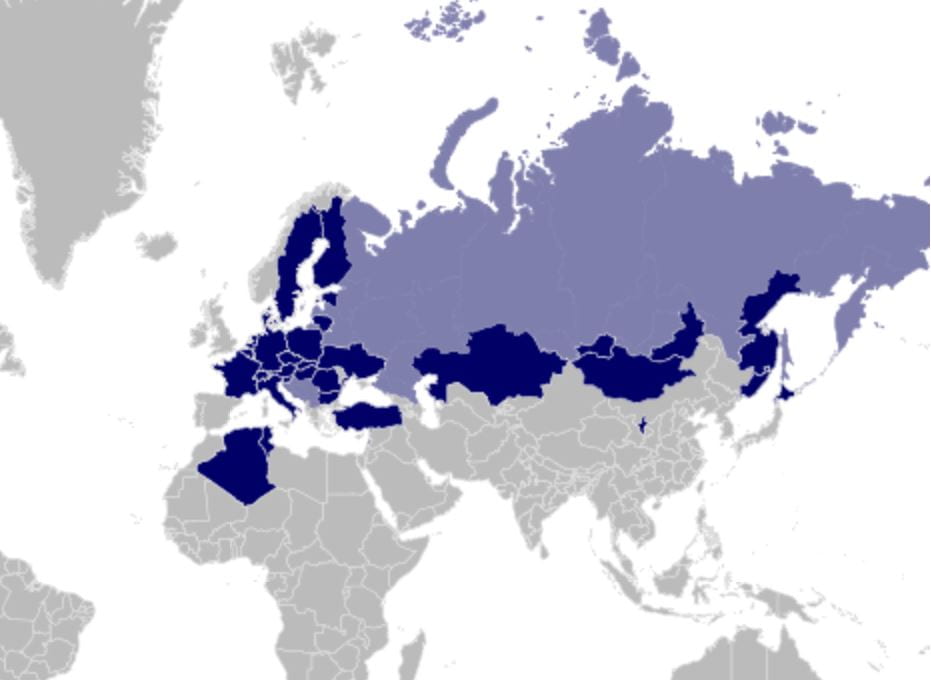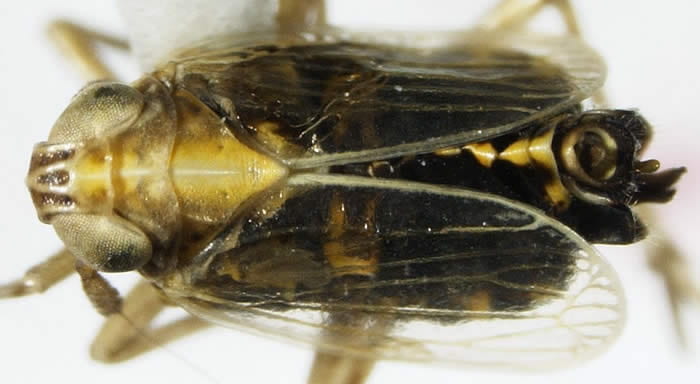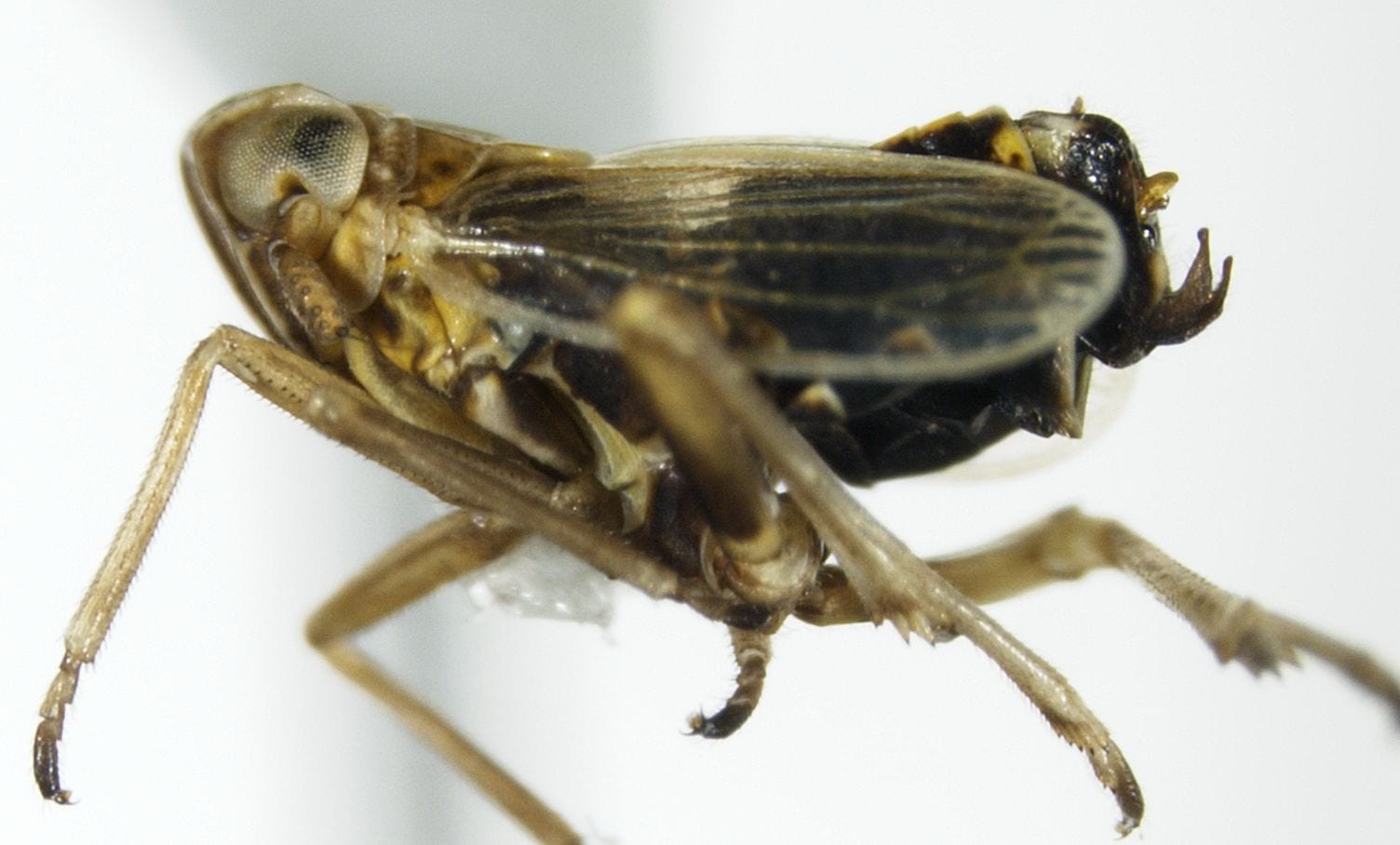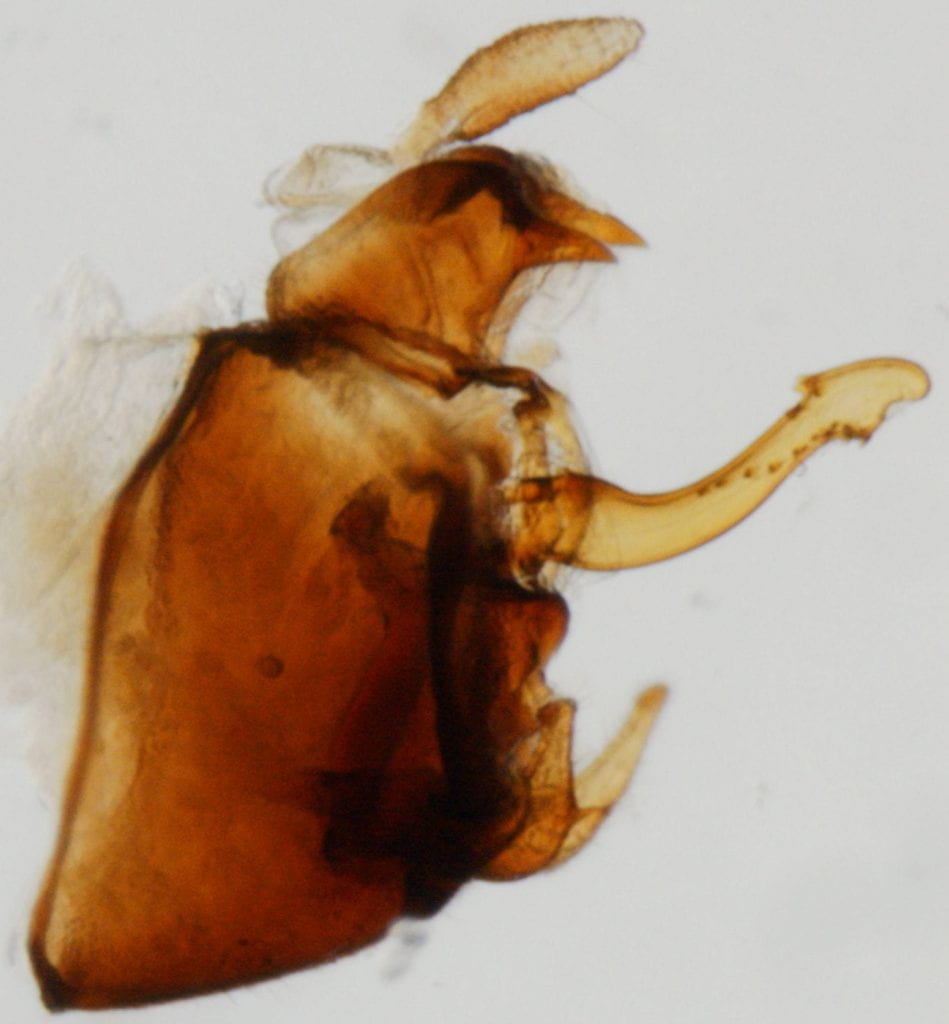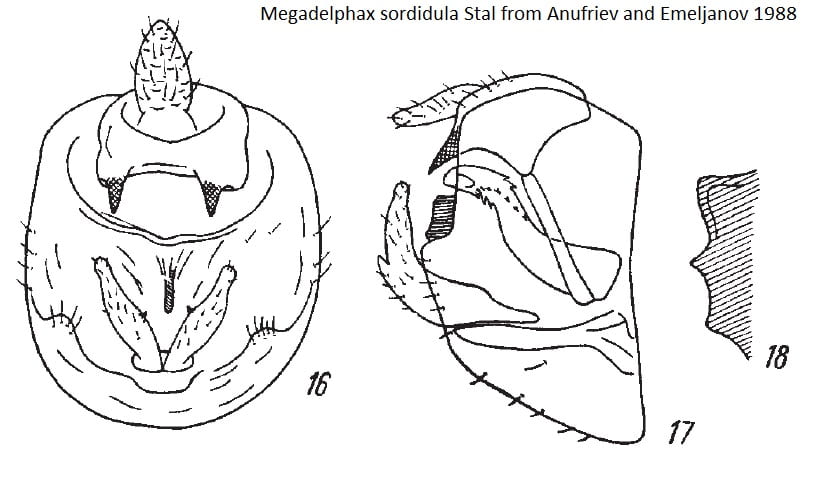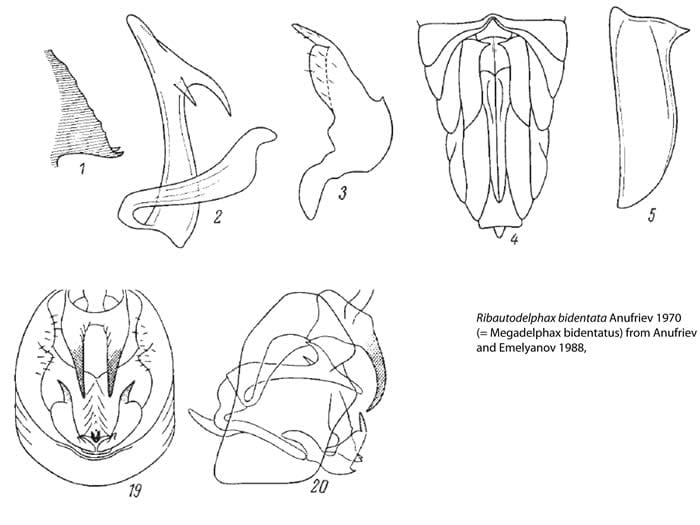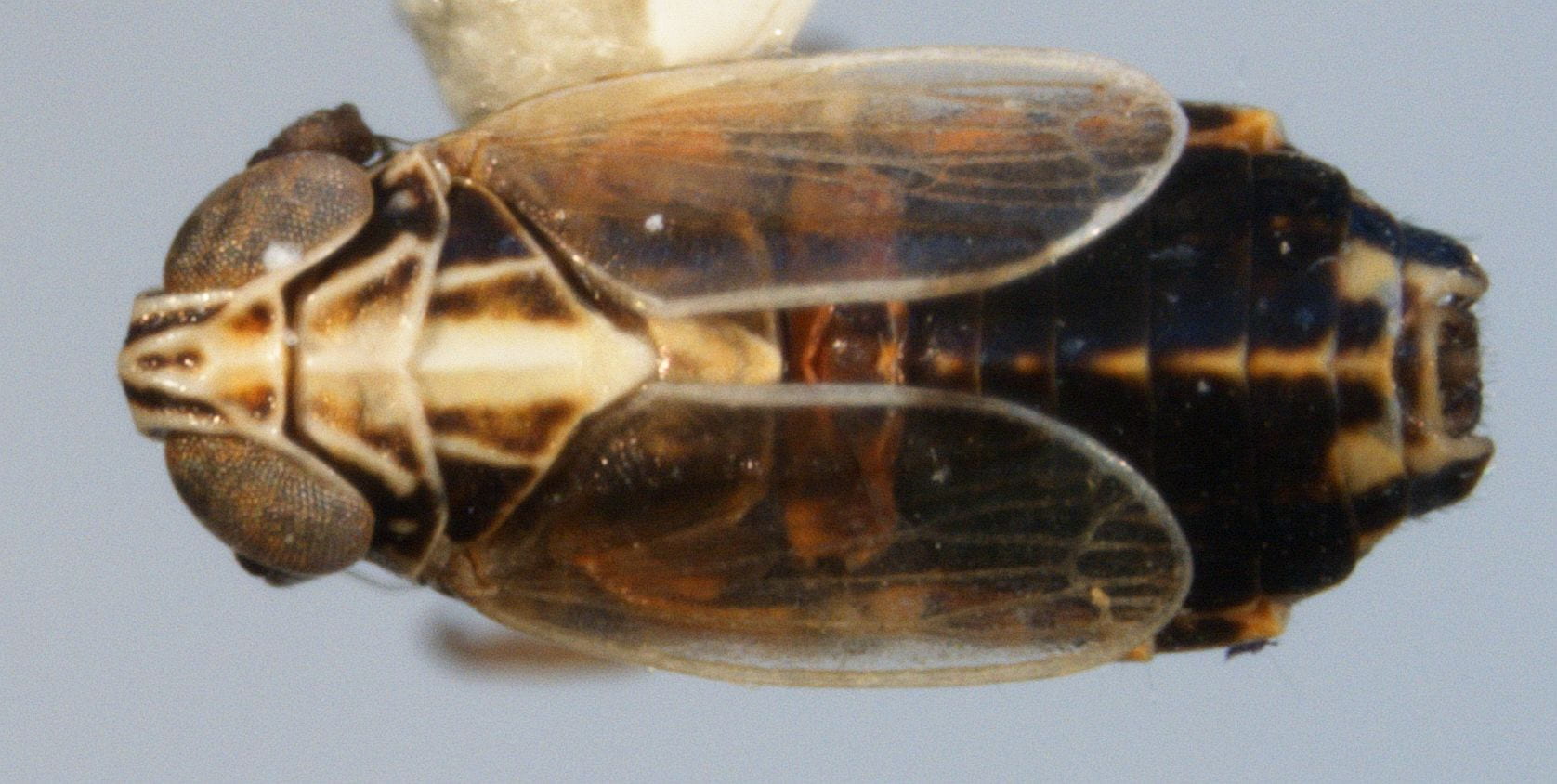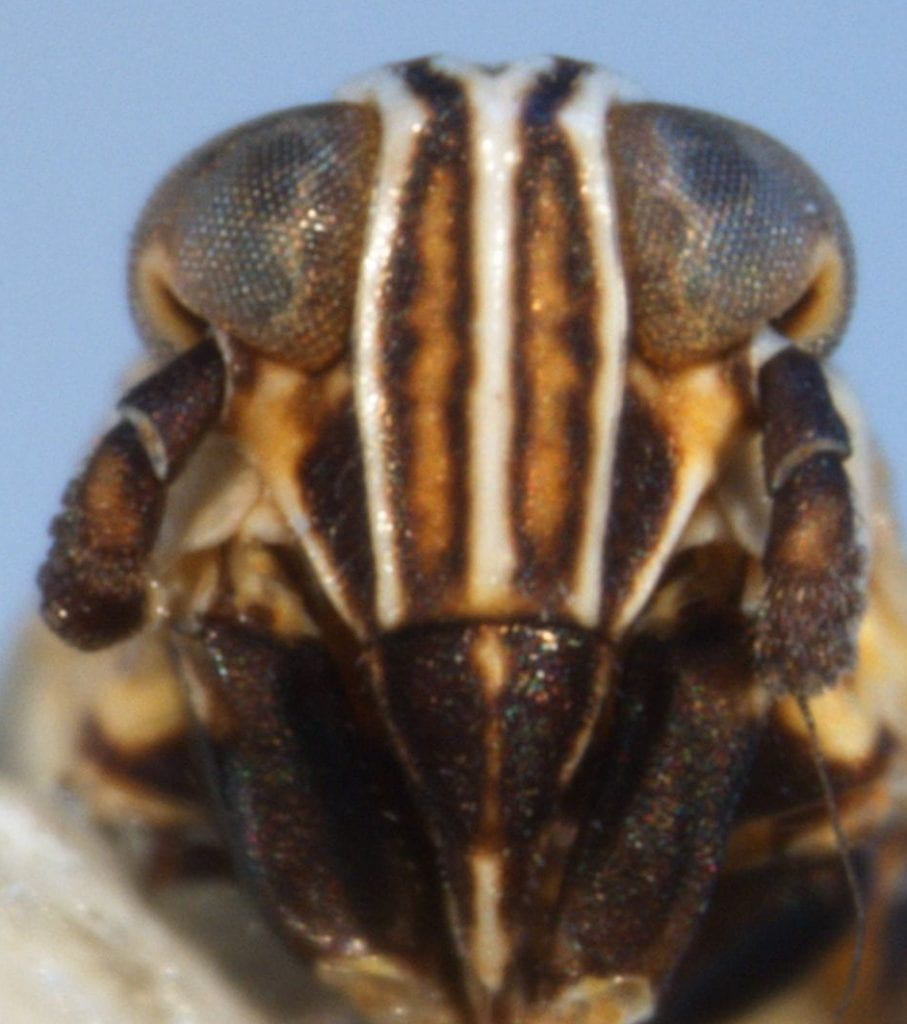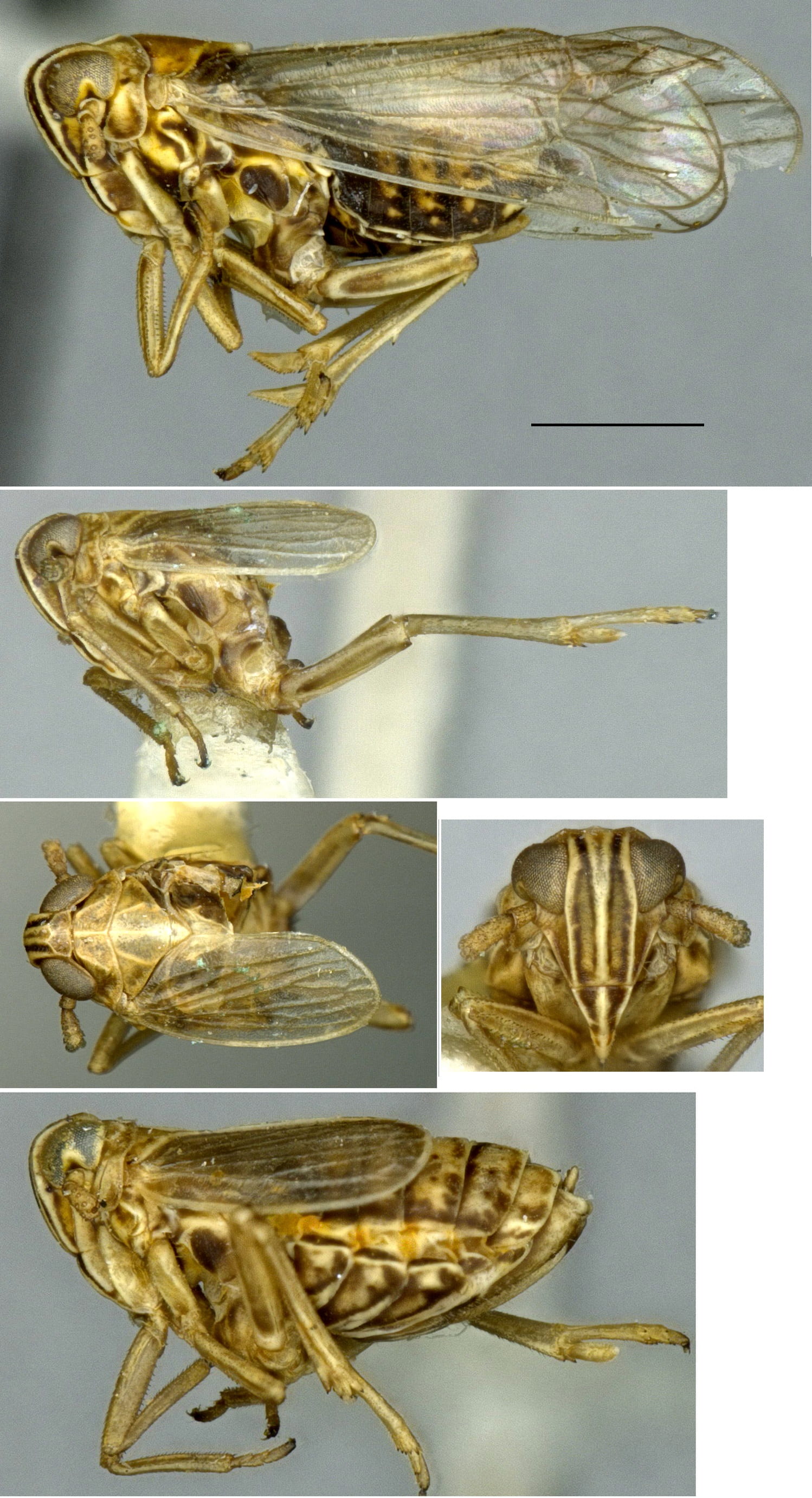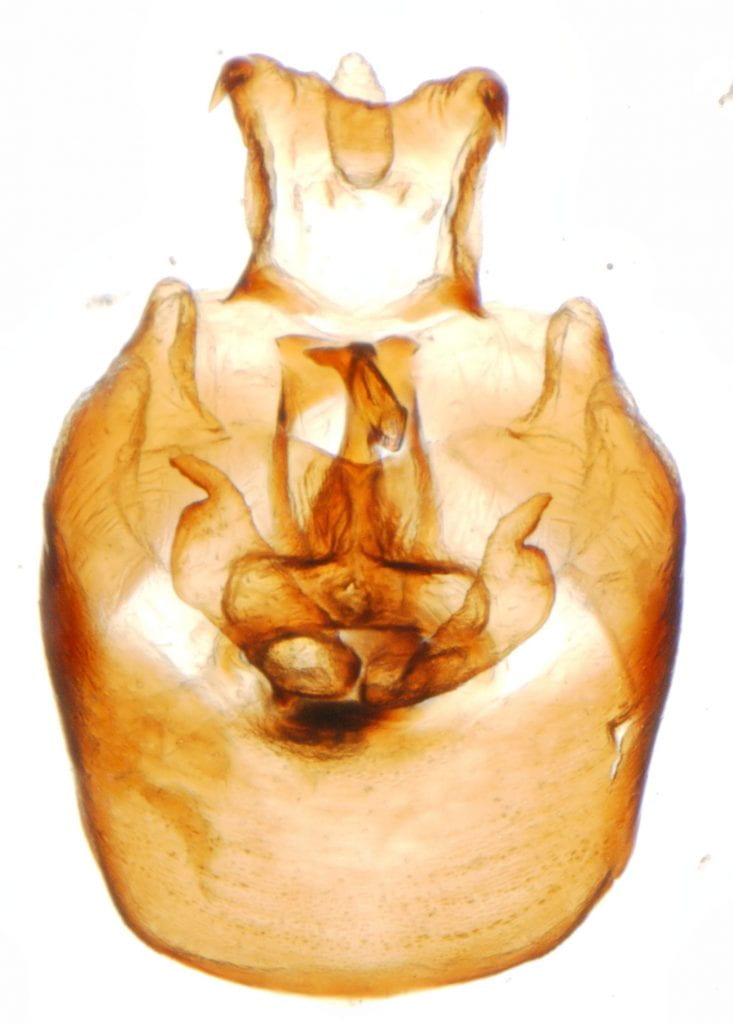[back to Higher Classification of Delphacidae]
[back to A checklist of New World delphacid species]
Contents
Family Delphacidae Leach, 1815
Subfamily Delphacinae Leach, 1815
Tribe Delphacini Leach, 1815
Genus Megadelphax Wagner, 1963
Type species (in original combination): Delphax sordidula Stål, 1853.
Distribution
Palearctic; one species reported in eastern Canada.
Recognized species
(distribution information may be incomplete)
There are nine recognized species in the genus (divided into subgenera by Emeljanov, 1982):
Subgenus Megadelphax Wagner, 1963
Megadelphax amoena Logvinenko, 1977 – Russia (Georgia)
Megadelphax bidentatus Anufriev, 1970) – Japan (Hokkaido), Russia (Chita, Khabarovsk, Kuril Islands, Primorye Tuva; Maritime Territory); Canada: Labrador, Newfoundland, Ontario, Quebec
= Ribautodelphax bidentatus Anufriev, 1970
Megadelphax cornigera (Kusnezov, 1929) – Russia, Turkestan, Mongolia; Inner Mongolia (Ningxia)
= Liburnia cornigera Kusnezov, 1929; original combination.
= Delphacodes cornigera (Kusnezov, 1929); comb. by Emeljanov (1977: 109).
= Delphacodes angara (Kusnezov, 1929).
= Liburnia angara Kusnezov, 1929
Megadelphax haglundi (Sahlberg, 1871) – Austria, Czech Republic, France, Germany, Moravia, Mongolia, Russia (Primorye), Sweden,
= Liburnia haglundi Sahlberg, 1871
= Delphax haglundi (Sahlberg, 1871); comb. by Puton 1875: 121.
= Delphacodes haglundi (Sahlberg, 1871); comb. by Metcalf, 1943: 452.
=“Calligyphona” haglundi (Sahlberg) according to Dlabola 1955: 122.
= Megadelphax haglundi (Sahlberg, 1871); comb. Ossiannilsson 1978: 115 (see also Emeljanov 1982: 85)
= Tyrphodelphax haglundi (Sahlberg, 1871); by Nast 1972: 60 (may not be original source of combination)
= Megadelphax paulus Emeljanov, 1972; by Emeljanov 1982.
Megadelphax kangauzi Anufriev, 1970 – Russia (Maritime Territory), Mongolia
Megadelphax paulus Emeljanov, 1972 – Mongolia
Megadelphax sobrinus Dlabola, 1967 – Mongolia
Megadelphax sordidulus (Stål , 1853) – Widespread Europe (East Palaearctic; Austria, Belgium, Bulgaria, Czech Republic, Estonia, Finland, France, Germany, Hungary, Italy, Lithuania, Poland, Romania, Russia (South European Russia, North European Russia), Slovakia, Slovenia, Sweden, Switzerland, Netherlands, Yugoslavia, Latvia?), North Africa, Kazakhstan, Russia, Mongolia
= Delphax sordidulus Stal, 1853
= Delphacodes sahlbergi Metcalf, 1943
Megadelphax subsymmetrica Logvinenko, 1977 – Russia (Caucasus)
Subgenus Polytropa Emeljanov, 1982 (nec. Swainson 1840)
Megadelphax vilbastei Emeljanov, 1982 – Russia
Note: Megadelphax bidentatus was reported from Canada by Maw et al. (2000) in the genus Ribautodelphax. This species was moved to to Megadelphax by Vilbaste (1980: 14), but has subsequently been treated (e.g., Anufriev and Emeljanov 1988) as Ribautodelphax. I have not seen an explicit definitive statement on the placement of this species (offhand it looks to be Ribautodelphax).
Economic importance
Megadelphax sordidulus is a putative vector of Phleum green stripe virus (PGSV) (e.g., Lindsten 1979).
Reported Hosts
Megadelphax sordidulus is reported from tall oatgrass (Arrhenatherum elatius), common oat (Avena satvia), timoth grass (Phleum pratense), wheat (Triticum sp.), and Meadow Foxtail Alopecurus pratensis. (Host information from Wilson wt al. 1994, Holzinger et al. 2003, Söderman 2007).
Parasites and predators
Gonatopus helleni (Raatikainen, 1961), Gonatopus formicicolus (Richards, 1939), Haplogonatopus oratorius (Westwood) (Dryinidae) by Olmi (1994)
Recognition
Keys to genus (and species) for Palearctic taxa can be found in Anufriev and Emeljanov (1988) and Holzinger et al. (2003) (the former illustrates more species).
Description of genus from Anufriev and Emeljanov (1988: 385-387)
“Head comparatively small; macrocoryphe noticeably longer than wide. Eumetope 2.5-3 times as long as wide; its sides more or less straight, parallel or slightly convex. Carinae on head sharp; median carina of eumetope becoming bifurcate on the turn into acrometope; lateral carinae of head slightly obtuse-angular concave on the turn into acrometope. Carinae of disc of pronotum not reaching its posterior margin. In brachypters, fore wings usually rounded at apex and reaching the middle of abdomen. Postibial spur small, with 14-21 lateral denticles. Male. Pygofer slightly compressed laterally; dorsal excision distinct; lateral edging without a cut, but thicker in lower part than in upper part. Anal tube with a pair of separate teeth ventrally, which usually are parallel to each other. Bridge of pygofer often with median ridge, and with a projection on it in lower part. Styli becoming thinner to apex, with apices slightly thickened or (more rarely) narrowed and slanting laterad. Aedeagus moderately elongate, weakly bent dorsad, sometimes in that case apex slightly slanting ventrad; aedeagus with asymmetrical [p. 386] arrangement of combs of teeth and gonopore. Gonopore more or less ventral, subapical, sometimes noticeably shifted to the right. ”
Key to species of Russia modified from Anufriev and Emeljanov (1988)
1. Styli gradually narrowing to slightly thickened, capitate apex. (Subgenus Megadelphax) … 2
1– Styli more or less parallel-sided, but sharply narrowing before apex; the thin apex slanting laterad, forming a kind of excision between apex and thick part of shaft. (Subgenus Polytropa Em.). – Pale, whitish yellowish. Head with dark brown areas between carinae, except coryphe. Fore wings with contrasting dark brown spot at apex of clavus. In male, venter, legs and whole abdomen dark brown, middle parts of all abdominal tergites and posterior margins of posterior tergites light. 2.8-3.2. – S Prim.; E Chita Prov. – In herb layer of light birch forests. Mid-July. … M. (Polytropa) vilbastei
2. Processes of anal tube long, directed more or less downwards, parallel to each other … 3
2– Processes of anal tube short, directed more or less transversely, to each other. Carinae of head whitish, areas between them dark brown, only posterior pits of macrocoryphe light; in male, discs of pronotum and scutellum light, lateral parts brown, sides of pronotum whitish, fore wings light, semihyaline. In male, thoracic pleura, coxae and most part of abdomen dark brown, legs brown, middle parts of tergites with an uneven red-brown stripe widening backwards. In female, whole body, except head, without pattern, only black punctures noticeable on abdominal tergites. 2.9-3.4, macropters up to 4.9. – Amur., Prim.; [p. 388] Transbaikal, Mongolia. In moist meadows in river flood plains and near brooks. Late June to early August. (Figs. 292: 9-15) … M. kangauzi
3. Styli without subbasal medial small tooth … 4
3– Styli with well developed subbasal medial small tooth. – Carinae on head light, interspaces brown; in male, carinae often edged by dark brown dim stripes. Thorax light brown dorsally. A whitish, not contrasting stripe running from posterior part of vertex through middles of discs of pronotum and mesonotum. Forewings semihyaline, grayish or yellowish. In female, abdomen nearly always light, without pattern; in male, abdomen nearly black, with light small spots on midline of tergites and also between them on posterior segments. 3.2-4.4. Macropters up to 5.1. – Mag., Kamch.; C Yakutia, Transbaikal, Tuva, S Siberia, Kazakhstan, C Tien Shan. – Mongolia, Europe, N Africa. – In meadows with grasses. Late June to August. (Figs. 292: 16-18; 293: 1-8) … M. sordidula
4. Bridge of pygofer with median carina from upper to lower margin; carina projecting in lower part in the shape of a tooth. Dark brown, with light and white pattern, as dappled. Carinae on head and posterior pits of macrocoryphe light; areas between carinae dark brown; on midline of eumetope lobes, pigment weakened to reddish brown. Carinae of pronotum and scutellum light; sides of pronotum white; a white stripe running on midline from vertex to pronotum and scutellum. Fore wings semihyaline, grayish, with brownish stripe along furcate vein of clavus; marginal vein whitish, but apex of clavus slightly darkened. Abdomen dark brown, with light spots on midline, on sides, and also between these lines in female. Venter and legs dark brown, but pleura of mesothorax light. 2.1-3, macropters up to 4.1. – Amur.; C Yakutia, Transbaikal, Tuva. – Mongolia. – In dry, mostly steppe meadows, in dry and sandy areas in light forests, woodless slopes
of southern exposure, etc. Early June to late July. … M. cornigera
4– Bridge of pygofer without carina in upper part, also projecting in the shape of carina in lower part. Lighter. In male, areas between carinae on metope brown, coryphe, pronotum and scutellum light brown with white carinae, sides of pronotum also white in upper part; fore wings light, semihyaline; abdomen dark brown with light brown small spots. In female, pattern is developed only on head, the rest of body pale straw-yellow. 2.2-3, macropters up to 3.8. – ?Amur. – N Mongolia (Khangai, Khentei Mts.), S. Sweden, Czechoslovakia. – In moist meadows. Mid-June to mid-July. (Figs. 294: 1-11) … M. haglundi
Megadelphax sordidulus
From Gernot Kunz Kunzweb Gallery.

Megadelphax sordidulus by Gernot Kunz from FLOW.
Megadelphax cornigera
Online Resources
FLOW.
Fauna Europaea.
Discover life.
3i.
EOL.
Kunzweb.
BOLD.
Molecular resources
BOLD has data for 2 specimens of Megadelphax sordidulus. Genbank has at least some data for 4 species (28 Oct. 2018).
Selected references
Alma, A., P.P. Chen., V. D’Urso, A. Guglielmino, J. Hollier, G. Kunz, P. Lauterer, I. Malenovský, P.J Mazzoglio., H. Nickel, R.N. Aldini, T. Rinttala, G. Seljak, M. Seyring, G. Söderman, M. Wilson and W. Witsack. 2009. Auchenorrhyncha collected in the Canavese district (Northwest Italy) (Hemiptera, Auchenorrhyncha). Cicadina 10: 119-125.
Anufriev, G. A. 1970. New east-Asiatic Delphacids from the genera Megadelphax Wagner and Ribautodelphax Wagner (Homoptera, Delphacidae. Bulletin de l’Academie Polonaise des Sciences cl. II. 18(3):141-146.
Anufriev, G. A. 2009. Cicadina. p. 52-69. In: 2009. Insects of Lazovsky Nature Reserve., Russian Academy of Sciences, Far Eastern Branch, Institute of biology and soil Science, Vladivostok Dalnauka (Russia).
Anufriev, G. A. and A. F. Emeljanov. 1988. Volume II: Homoptera and Heteroptera. In: P.A. Lehr (ed.). Keys to the Insects of the Far East of the USSR in Six Volumes, Transliteration of the Russian title: Opredelitel’ nasekomykh Dal’nego Vostoka SSSR v shesti tomakh. Vol. 2. Ravnokrylye i poluzhestkokrylye. In: P.A. Lehr (ed.). Keys to the Insects of the Far East of the USSR in Six Volume. Nauka, Leningrad. [English translation]
Asche, M. 1982. Beitrage zur Delphaciden-Fauna Ungarns (Homoptera Cicadina Delphacidae). Marburger Entomologische Publikationen 1(7): 139-154.
Asche, M. 1982. Beitrage zur Delphaciden-Fauna der Turkei (Anatolien) (Homoptera Cicadina Delphacidae). Marburger Entomologische Publikationen 1(7): 71-98.
Asche, M. 1982. Beitrage zur Delphaciden-Fauna Jugoslawiens und Bulgariens (Homoptera Cicadina Delphacidae) in Marburger Entomologische Publikationen 1(7): 99-138.
Asche, M. and H. Hoch. 1986. Cixiidae and Delphacidae (Homoptera – Fulgoroidea) from Lebanon – a preliminary synopsis. Pp. 18-19. In: Proceedings of the 2nd International Congress Concerning the Rhynchota Fauna of Balkan and Adjacent Regions. Microlimni Prespa. Greece. Pp. 1-70.
Bartlett, C. R., L. B. O’Brien and S. W. Wilson. 2014. A review of the planthoppers (Hemiptera: Fulgoroidea) of the United States. Memoirs of the American Entomological Society 50: 1-287.
Dlabola, J. 1955. Faunistik und neue Arten der Palaearktischen Zikaden (Homoptera, Auchenorrhyncha). Acta Entomologica Musei Nationalis Pragae 30, 446: 121-128.
D’Urso, V. 1995. Homoptera Auchenorrhyncha. In: Checklist delle specie della Fauna Italiana 42: 1-35.
Emeljanov, A. F. 1977. Leaf-hoppers (Homoptera, Auchenorrhyncha) from the Mongolian People’s Republic based mainly on materials of the Soviet-Mongolian zoological expeditions (1967-1969). Nasekomye Mongolii [Insects of Mongolia] 5: 96-195.
Emeljanov, A. F. 1982. Fulgoroidea (Homoptera) collected in the Mongolian People’s Republic by the entomofaunistical group of the Soviet Mongolian complex biological expedition in 1970-1975. Nasekomye Mongolii [Insects of Mongolia] 8: 69-122. [Russian]
Fujinuma, S. and M. Hayashi. 2016. New records of seventeen Delphacids (Hemiptera: Fulgoromorpha) from Japan. Japanese Journal of Systematic Entomology 22(2): 273-281.
Gębicki, C., D. Świerczewski and J. Szwedo. 2013. Planthoppers and Leafhoppers of Poland (Hemiptera: Fulgoromorpha et Cicadomorpha). Systematics, Check-list, Bionomy. The Monograph. Annals of the Upper Silesian Museum, Entomology 21-22: 1-245.
Gunthart, H. 1997. Die Zikaden des Schweizer Nationalparks und seiner Umgebung (Insecta: Auchenorrhyncha) in Nationalpark-Forschung in der Schweiz 88: 1-33.
Gunthart, H. and R. Muhlethaler. 2002. Provisorische Checklist der Zikaden der Schweiz (Insecta: Hemiptera, Auchenorrhyncha). Denisia 04, zugleich Kataloge des OO. Landesmuseums, Neue Folge, 176: 329-338.
Heikinheimo, O. and M. Raatikainen. 1976. Megadelphax sordidula (Stal) (Homoptera), Delphacidae) as a vector of Phleum green stripe virus. Annales agriculturae Fenniae (1): 34-55.
Heller, F. 1996. Vier fur Deutschland neue Zikaden. Megadelphax haglundi (J. Sahlbg.), Arboridia erecta (Rib. 1931), Fruticidia sanguinosa (Rey 1891) und Recilia horvathi (Then 1896) (Homoptera: Auchenorrhyncha). Mitteilungen des entomologischen Vereins Stuttgart 31: 112-116.
Holzinger, W. E., I. Kammerlander and H. Nickel. 2003. Fulgoromorpha, Cicadomorpha excluding Cicadellidae. Volume 1. The Auchenorrhyncha of Central Europe. Brill Academic Publishing, Leiden, Netherlands.
Jankovic, L. 1975. Recueil des Travaux sur la faune d’Insectes de la France T. I. Odeljenje prirodno-matematickih Nauka Beograd (1975): 85-110.
Kusnezov. V. 1929. Beitrag zur Kenntnis der transbaikalischen Homopteren fauna. Wiener Entomologische Zeitung. Wien 46: 157-185 [164].
Leach, W. E. 1815a. Entomology. The Edinburg encyclopedia; conducted by David Brewster 9: 57-172. (family Delphacidae here).
Lindsten, K. 1979. Planthopper vectors and plant disease agents in Fennoscandia. Pp. 155- 178. In: K. Maramorosch and K.F. Harris, (eds.). Leafhopper vectors and plant disease agents. Academic Press, New York.
Logvinenko, V. N. 1970. New and little known leafhoppers of the family Delphacidae (Homoptera, Auchenorrhyncha) from southern districts of the USSR. Entomologicheskoe Obozrenie 49: 624-633.
Logvinenko, V. N. 1975. Fulgoroidny cicadovy Fulgoroidea. Fauna Ukrainy 20 (2): 1-287 [in Ukrainian].
Maw, H.E.L., R. G. Foottit, K.G.A. Hamilton and G.G.E. Scudder. 2000. Checklist of the Hemiptera of Canada and Alaska. NRC Research Press, Ottawa.
Metcalf, Z. P. 1943. General Catalogue of the Hemiptera. Fascicle IV, Fulgoroidea, Part 3, Araeopidae (Delphacidae). Smith College, Northhampton, Massachusetts.
Nast, J. 1972. Palaearctic Auchenorrhyncha (Homoptera). An annotated check list. Polish Scientific Publishers, Warszawa, 550 pp.
Nast, J. 1986. Notes on some Auchenorrhyncha (Homoptera) 6-10: 10. New faunistic records from Europe. Annales Zoologici Warszawa 40 (3): 301-307.
Nast, J. 1987. The Auchenorrhyncha (Homoptera) of Europe.n Annales Zoologici Warszawa 40: 535-661.
Nickel, H. 2003. The Leafhoppers and Planthoppers of Germany (Hemiptera, Auchenorrhyncha), Patterns and strategies in a highly diverse group of phytophagous insects, Pensoft Series Faunistica 28, Sofia, Bulgaria.
Olmi, M. 1994. The Dryinidae and Embolemidae (Hymenoptera: Chrysidoidea) of Fennoscandia and Denmark. Brill publishers, 98 pp.
Ossiannilsson, F. 1978. The Auchenorrhyncha (Homoptera of Fennoscandia and Denmark. Part 1: Introduction, infraorder Fulgoromorpha. Fauna Entomologica Scandinavica 7 (1): 1-222.
Ostapenko, K. A. 2008. Особенности биотопического распределения цикадовых ( Homoptera , Cicadinea ) в лесах полуострова Муравьева–Амурского, Приморский край [Peculiarities of the habitat distribution of Cicadinea (Homoptera) in the forests of the Muravyev-Amursky Peninsula, Primorsky Region.] A.I. Kurentsov’s Annual Memorial Meetings 19: 103-116.
Remane, R. and W. Frohlich. 1994. Vorlaufige, kritische Artenliste der im Gebiet der Bundesrepublik Deutschland nachgewiesenen Taxa der Insekten-Gruppe der Zikaden (Homoptera Auchenorrhyncha). Marburger Entomologische Publikationen 2(8): 189-232.
Remane, R. and W. Frohlich. 1994. Beitrage zur Chorologie einiger Zikaden-Arten (Homoptera Auchenorrhyncha) in der Westpalaarktis. Marburger Entomologische Publikationen 2(8): 131-188.
Qin, D. Z., X. D. Chen and Q. L. Men. 2009. A new record species of the genus Megadelphax Wagner and redescription of Eurybregma nigrolineata Scott (Hemiptera, Fulgoroidea, Delphacidae) from China. Acta Zootaxonomica Sinica 34: 654-658.
Raatikainen, M. 1970. Ecology and fluctuations in abundance of Megadelphax sordidulus (Stål) (Hom., Delphacidae). Annales Agricultura Fennici 9: 315-324.
Riedle-Bauer, M., B. Tiefenbrunner and W. Tiefenbrunner. 2006. Untersuchungen zur Zikadenfauna (Hemiptera, Auchenorrhyncha) einiger Weingärten Ostösterreichs und ihrer nahen Umgebung. [Auchenorrhyncha (Hemiptera) in and around vineyards of eastern Austria.] Linzer Biologische Beiträge 38(2) 1637-1654.
Sahlberg, J. R. 1871. Ofversigt af Finlands och den Skandinaviska hälfons Cicadariae. I. Notiser ur Sällskapets pro Fauna et Flora Fennica Förhandlingar 9(12): 1-506.
Söderman, G. 2007. Taxonomy, distribution, biology and conservation status of Finnish Auchenorrhyncha (Hemiptera: Fulgoromorpha et Cicadomorpha). The Finnish Environment 7: 1-101.
Stal, C. 1853. Nya svenska Homoptera. Ofversigt af Kongliga Svenska Vetenskaps-Akademiens Forhandlingar 10: 174-177.
Swierczewski, D. and A. Stroinski. 2011. Planthoppers and leafhoppers of the Przedborski Landscape Park (Hemiptera: Fulgoromorpha et Cicadomorpha). Polskie Pismo Entomologiczne 80: 277-290.
Vilbaste, J. 1971. Eesti Tirdid. Homoptera-Cicadinea I. (Tettigometridae, Cixiidae, Delphacidae, Achilidae, Issidae, Cicadidae, Aphrophoridae, Membracidae). Kirjastus “Valgus”, Tallinn. Pp. 1-284.
Vilbaste, J. 1980. [Cicada fauna of Tuva. OR Homoptera Cicadinea of Tuva] [Fauna tsikadovykh Tuvy]. Valgus, Tallin, Estonia.
Wagner, W. 1963. Dynamische Taxionomie, angewandt auf die Delphaciden Mitteleuropas. Mitteilungen des Hamburger Zoologischen Museums und Instituts 60: 111-180. [Delphacodes sahlbergi Metcalf, 1943]
Wilson, S. W., C. Mitter, R. F. Denno and M. R. Wilson. 1994. Evolutionary patterns of host plant use by delphacid planthoppers and their relatives. In: R.F. Denno and T.J. Perfect, (eds.). Planthoppers: Their Ecology and Management. Chapman and Hall, New York. Pp. 7-45 & Appendix [host references in appendix].

